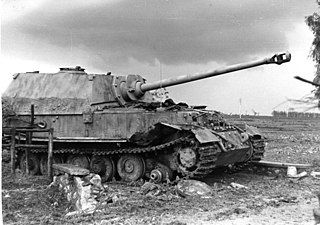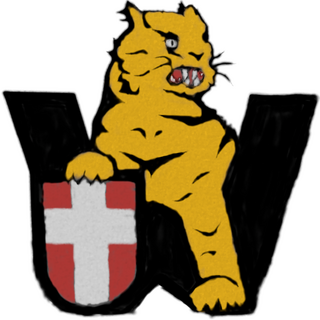
Michael Wittmann was a German Waffen-SS tank commander during the Second World War. He is known for his ambush of elements of the British 7th Armored Division during the Battle of Villers-Bocage on 13 June 1944. While in command of a Tiger I tank, Wittmann allegedly destroyed up to 14 tanks, 15 personnel carriers and two anti-tank guns within 15 minutes before the loss of his own tank. The news was disseminated by Nazi propaganda and added to Wittmann's reputation.

The Tiger II was a German heavy tank of the Second World War. The final official German designation was Panzerkampfwagen Tiger Ausf. B, often shortened to Tiger B. The ordnance inventory designation was Sd.Kfz. 182.. It was also known informally as the Königstiger. Contemporaneous Allied soldiers usually called it the King Tiger or Royal Tiger.

The Battle of Anzio was a battle of the Italian Campaign of World War II that took place from January 22, 1944 to June 4, 1944. The operation was opposed by German and by Italian Repubblica Sociale Italiana (RSI) forces in the area of Anzio and Nettuno.
The Battle of Cisterna took place during World War II, on 30 January–2 February 1944, near Cisterna, Italy, as part of the Battle of Anzio, part of the Italian Campaign. The battle was a clear German victory which also had repercussions on the employment of U.S. Army Rangers that went beyond the immediate tactical and strategic results of the battle.

The Sturmpanzer is a German armoured infantry support gun based on the Panzer IV chassis used in the Second World War. It was used at the Battles of Kursk, Anzio, Normandy, and was deployed in the Warsaw Uprising. It was known by the nickname Brummbär by Allied intelligence, a name which was not used by the Germans. German soldiers nicknamed it the "Stupa", a contraction of the term Sturmpanzer. Just over 300 vehicles were built and they were assigned to four independent battalions.
101st Heavy SS Panzer Battalion was a German heavy tank battalion in the Waffen-SS during World War II. With the introduction of new Tiger II tanks in late 1944, the unit was renumbered as the 501st Heavy SS Panzer Battalion.
The Fallschirm-Panzer-Division 1. Hermann Göring was a German Luftwaffe armoured division. The HG saw action in France, North Africa, Sicily, Italy and on the Eastern Front during World War II. The division began as a battalion-sized police unit in 1933. Over time it grew into a regiment, brigade, division, and finally was combined with the Parachute-Panzergrenadier Division 2 Hermann Göring on 1 May 1944 to form a Panzer corps under the name Reichsmarschall. It surrendered to the Soviet Army near Dresden on 8 May 1945.

The Panzer-Lehr-Division was an elite German armoured division during World War II. It was formed in 1943 onwards from training and demonstration troops stationed in Germany, to provide additional armored strength for the anticipated Allied invasion of western Europe. On 4 April 1944, the division was officially designated as the 130th Panzer Division; however, it is usually referred to as the Lehr Division. It was the only Wehrmacht Panzer division to be fully equipped with tanks and with halftracks to transport its mechanized infantry. On several occasions it fought almost to destruction, in particular during Operation Cobra, and by the end of the war in Europe bore little resemblance to the unit that had originally been activated.
The 503rd Heavy Panzer Battalion was a German heavy Panzer Abteilung equipped with Tiger I and Panzer III tanks. In 1944, it was re-equipped with the new Tiger II. The battalion saw action on the Eastern and Western Fronts during World War II. As with other German heavy tank battalions, it was normally not assigned to a single corps, but shuffled around according to war circumstances. Later the battalion became part of the newly formed Panzer Corps Feldherrnhalle as the Feldherrnhalle Heavy Tank Battalion.

A German heavy tank battalion was a battalion-sized World War II tank unit of the German Army (1935–1945), equipped with Tiger I, and later Tiger II, heavy tanks. Originally intended to fight on the offensive during breakthrough operations, the German late-war realities required it to be used in a defensive posture by providing heavy fire support and counter-attacking enemy armored breakthroughs, often organised into ad hoc Kampfgruppen.

The Trasimene Line was a German defensive line during the Italian Campaign of World War II. It was sometimes known as the Albert Line. The German Commander-in-Chief (C-in-C), Generalfeldmarschall Albert Kesselring, used the line to delay the Allied northward advance in Italy in mid June 1944 to buy time to withdraw troops to the Gothic Line and finalise the preparation of its defenses.

The 502nd Heavy Panzer Battalion was a German heavy tank battalion during World War II. The battalion was the first unit to receive and field the Tiger I. It fought on the Eastern front. It was one of the most successful German heavy tank battalions, claiming the destruction of 1,400 tanks and 2,000 guns. Otto Carius, one of the best German tank aces, was a member.

The 13th Cavalry Regiment is a unit of the United States Army. The 2nd Squadron is currently stationed at Fort Bliss, Texas, as part of the 3rd Armored Brigade Combat Team, 1st Armored Division.

Operation Perch was a British offensive of the Second World War which took place from 7 to 14 June 1944, during the early stages of the Battle of Normandy. The operation was intended to encircle and seize the German occupied city of Caen, which was a D-Day objective for the British 3rd Infantry Division in the early phases of Operation Overlord. Operation Perch was to begin immediately after the British beach landings with an advance to the south-east of Caen by XXX Corps. Three days after the invasion the city was still in German hands and the operation was amended. The operation was expanded to include I Corps for a pincer attack on Caen.

The 715th Infantry Division was a German infantry division which fought during World War II.
The 501st Heavy Panzer Battalion was a German heavy Panzer Abteilung equipped with heavy tanks. The battalion was the second unit to receive and use the Tiger I heavy tank, changing to Tiger IIs in mid-1944.
The 102nd Heavy SS Panzer Battalion was a German heavy tank battalion of the Waffen-SS during World War II. It fought as part of the II SS Panzer Corps during the Battle of Normandy and was nearly destroyed. Renumbered as 502nd Heavy SS Panzer Battalion in late 1944, the unit was destroyed in the Halbe Pocket in Spring 1945.

The 653rd Heavy Panzerjäger Battalion was a tank destroyer unit of the German Wehrmacht active during World War II. It was equipped with Ferdinand and later Jagdtiger tank destroyers. Elements of the battalion served on the Eastern, Western, and Italian fronts between 1943 and 1945.
The 512th Heavy Panzerjäger Battalion was an independent tank destroyer battalion of the German Wehrmacht during World War II.

The 506th Heavy Panzer Battalion was a german heavy Panzer Abteilung equipped with Tiger I tanks until 28 July 1944. During the period from 20 August to 12 September 1944, it was re-equipped with a full complement of 45 Tiger Ausf. B tanks. Some of the first Tiger IIs delivered to the 506th were examples fitted with the early production turret. The battalion saw action on the Eastern and Western Fronts during World War II. As with other German heavy tank battalions, it was attached as needed to larger formations. The 506th was unique in being the only Tiger battalion to include a fourth company. German: schwere Panzerkompanie Hummel, equipped with Tiger I tanks, was consolidated with the 506th in 1944. It was also unique in that it regularly received new vehicles and replacements from other units to maintain a full complement. The unit served until the collapse of the Ruhr Pocket in April 1945, being officially disbanded by the battalion commander on 14 April. The unit performed well despite often poor conditions of deployment, officially credited with over 400 tank kills during its service with fewer than 75 combat losses.





















